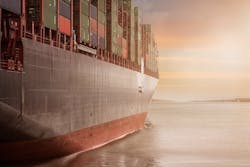It’s likely easier to talk about which part of the global supply chain isn’t strained, halted, more expensive, or otherwise not working.
From the high-profile shortage of semiconductors affecting new vehicle production to the shipments of everyday goods and components, the sharp COVID-19 dip in labor and subsequent surge in demand—coupled with numerous other issues—are causing havoc for suppliers.
International shipping times have increased, as has the price for those shipments. When they do arrive, they meet crowded ports with labor shortages, much of that due to a COVID-19 variant that continues to spread.
There are difficult stories everywhere. The New York Times wrote about a domestic tricycle company that was sitting on $2 million of inventory while waiting for a single part from overseas to complete the trikes. The cost of a simple magnet used in electronics rose 50 percent, according to one manufacturer in a recent Bloomberg report.
In the quick maintenance business, suppliers have had a very tough year.
“In 30 years, I've never seen this,” says Matt Callahan, vice president at Filpac. “I’ve seen our fair share of dock strikes that might delay products coming in overseas a week or two, three weeks tops.”
But the delays that the industry has seen over the past year have outstretched previous spikes. Callahan says that some internationally sourced products that used to be on a 90-day delivery cycle could now take six to eight months. Even if some products get onto ships quickly, they’re meeting clogged U.S. ports of entry with ships waiting to be unloaded.
Put time aside, and there have been aggressive spikes in shipping container costs. Callahan says that a container that was once $3,000 could be as high as $20,000 or more now. Bloomberg cited one industry analyst who said that container costs from Shanghai to Los Angeles rose sixfold from May 2020 to summer 2021. Maritime Executive cited a source that said short-term contracted rates for China to the U.S. West Coast were up 102 percent over 2020.
It’s an industry-wide headache. Callahan says that his company has been able to maintain a good fill rate through it all, but it has not been easy.
“We’ve kind of thrown our hands in the air and say it is what it is,” he says. “We’ve done the best we can, and I think we’ve done a really good job through this period.”
Filter Fumble
As if suppliers weren’t strained enough, another curveball came in mid-2021 when Service Champ and Champion Labs cut ties with one another over filter manufacturing.
Service Champ began alerting customers in the summer. In one customer letter from July, the company announced the situation and that it would seek substitution products.
“As you may or may not yet be aware, Service Champ’s key Filter supplier has claimed force majeure and is no longer supplying us filters. We strongly object to the supplier’s position and are pursuing all available remedies,” the letter said.
Through a spokesman, Service Champ declined to give any comment to NOLN. Champion Labs did not respond to a request for comment.
At the time of the bulletin, Service Champ said there would be an “extended time period” starting in August, during which filters would be out of stock. The result was an acute scramble for filters, with quick maintenance operators pivoting to online retailers and local auto parts stores.
Other suppliers were inundated with new orders. Callahan says that suppliers have done the best they could to accommodate some new orders in a challenging environment for normal volumes.
“It exacerbated an already strained supply,” Callahan says.
Challenges Ahead
UPS international president Scott Price told the news agency AFP that 2022 is looking to be just as disruptive as 2021.
While the exact timeline is a moving target, that’s the general consensus among experts. With transportation strains continuing, COVID-19 still spreading, and products demand continuing, these challenges will remain for the foreseeable future.
Callahan hopes that if hiring begins to pick up, then an improvement on the labor front could help to get supplies moving again. But that’s just one piece of a vast, complex system that’s experiencing unprecedented strains.
“There's no signs that show that things are going to relax or calm down, at least in the supply chain, regardless of labor,” Callahan says.
He says that Filpac has been trying to work closely with clients to help them serve customers. Even box manufacturers are delayed, which makes simple packaging of products more difficult.
For operators, those relationships are crucial during this time.





